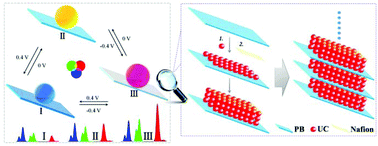In situ reversible color variation of a ready-made upconversion material using the designed component of a three-state fluorescence switching system†
Abstract
In recent years, upconversion materials have attracted considerable attention because of their unique physicochemical features. Numerous studies have focused on the synthesis of upconversion materials with different colors. However, an easier way to vary the upconversion colors without changing the materials’ components has not been extensively studied. In this study, we realized the in situ color variation of the designed upconversion material with the help of a three-state fluorescence switching hybrid device. The device was composed of Prussian blue and upconversion materials; the former element functioned as a fluorescence resonance energy transfer acceptor and the latter acted as a donor. Smartly applying the RGB color model guaranteed multicolor of the device. Moreover, the highest fluorescence contrast of the three-state fluorescence switching system was 86% (larger than the result of a previous study), and the three-state reversibility was remarkable; this was probably owing to the unique layer-by-layer dripping/electrodepositing assembly method. To the best of our knowledge, the in situ reversible color variation of the ready-made upconversion material has been demonstrated for the first time.



 Please wait while we load your content...
Please wait while we load your content...